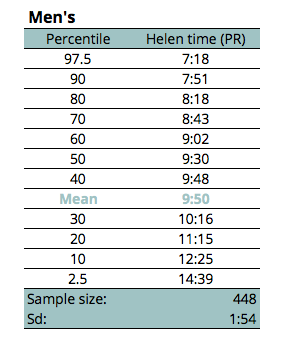A typical question you have after you do the Helen workout for the first time in CrossFit is, “Was that a good time?”
Helen is a quick little workout of three rounds for time of:
A quick search on the world wide web conventionally says that about 11:30-12:30 minutes is an average time to complete Helen in. Box Mag has much faster expectations, claiming that faster than 8 minutes is good to excellent, while anything slower than 8 minutes is “fair.”
According to results from participants in the CrossFit Open, the answer seems to be about somewhere in the middle. I extracted data from 5,376 CrossFit Open participants, 573 of which reported their best Helen time.
 Of these, 448 were men. The mean Helen time for men was 9 minutes and 50 seconds, with a standard deviation of 1 minute and 54 seconds. In a normal distribution, this means that 68% of men should complete Helen in the range of 7:56-11:44, and 95% of men should complete Helen in the range of 6:02-13:38.
Of these, 448 were men. The mean Helen time for men was 9 minutes and 50 seconds, with a standard deviation of 1 minute and 54 seconds. In a normal distribution, this means that 68% of men should complete Helen in the range of 7:56-11:44, and 95% of men should complete Helen in the range of 6:02-13:38.
Notice that the mean time is much lower than the 50 percentile time and even lower than the 40 percentile time. This makes sense. Helen times can get infinitely slower than the median time. However, Helen times cannot get infinitely faster. Therefore, the slower side of the median should skew the mean, like we see in this data.
 One-hundred twenty five women self reported their Helen times. The mean Helen time for women was 11 minutes and 14 seconds, with a standard deviation of 2 minutes and 14 seconds. In a normal distribution, this means that 68% of women should complete Helen in the range of 9:00-13:28, and 95% of women should complete Helen in the range of 6:46-15:42.
One-hundred twenty five women self reported their Helen times. The mean Helen time for women was 11 minutes and 14 seconds, with a standard deviation of 2 minutes and 14 seconds. In a normal distribution, this means that 68% of women should complete Helen in the range of 9:00-13:28, and 95% of women should complete Helen in the range of 6:46-15:42.
I then took the men’s data to see if there was a correlation between body weight and Helen times and height and Helen times. As expected, there is a slight correlation.
For weight, when we run a linear regression for correlation between weight and Helen time, we get the equation: Helen-time(seconds) = 0.6786*Weight(lbs) + 463.85.
Based on the equation, we should expect a better mean Helen time for men who weigh 150 lbs compared to men who weigh 200 lbs. In this model, men who weigh 150 lbs should use a figure of 9:22 as the mean time to go off of. Men who weigh 200 lbs should use a figure of 10:00 exactly as the mean time to go off of. In other words, we would expect 1,000 men who weighed 150 lbs to perform 38 seconds faster than 1,000 men who weighed 200 lbs.
We also see a slight correlation with height. For height, when we run a linear regression for correlation between height and Helen time, we get the equation: Helen-time(seconds) = 0.9743*Height(inches) + 522.48, showing the shorter the better. However, this height model is likely confounded by weight. It could be that shorter is only better because it means lighter in weight.
To test this, we can run a multiple linear regression with both height and weight as independent variables, to see how height and weight interact with each other and avoid some confounding. When we run a multiple linear regression, we get the equation:
Helen-time(seconds) = 674.3366 – (3.7339*Height(inches)) + (0.9649*Weight(lbs))
This model suggests that height is actually beneficial in Helen, barring no increase in weight as height increases. For every one inch increase in height, if there is no additional increase in weight, you shave off 3.73 seconds off your Helen time.
This model also says weight is even more influential on Helen times than in the weight-only model. In this multiple linear regression model, we’d expect a 150 lb man of average height to finish Helen in 9:16, compared to a 200 lb man of average height to finish in 10:04.
What’s better for Helen? Being tall and thin for their height, or being short and built?
Let’s take a look at two extreme body types in last year’s CrossFit Games (from guys we know are as lean as possible):
In our model, if these guys were average athletes, we’d expect Orlando to get a Helen time of 9:49, while we’d expect Aja to get a time of 10:04.
Therefore, despite there being some advantage in being tall in the model, the natural weight gain you get in being tall likely negates all advantage you’d have. Plugging in measurements from guys like Orlando and Aja show that the smaller and built body type is the preferred body type in Helen as opposed to being tall and relatively thin.